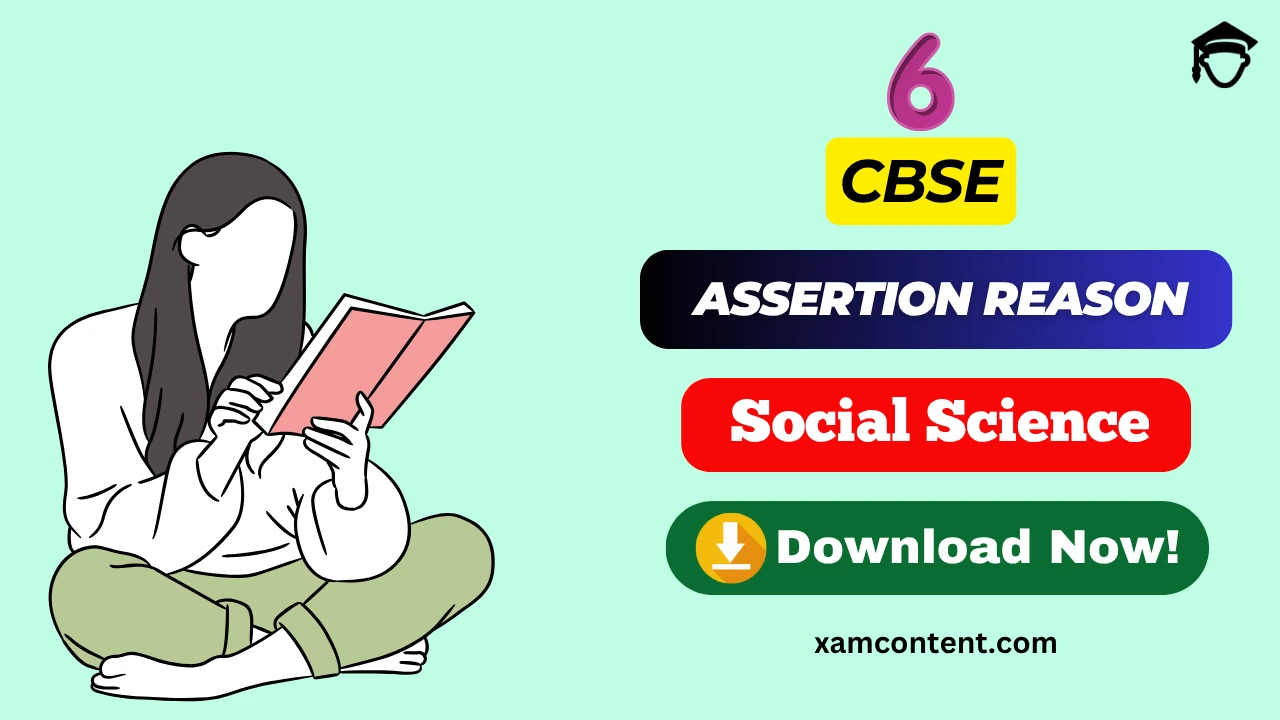Last Updated on November 16, 2025 by XAM CONTENT
Hello students, we are providing assertion reason questions for class 6. Assertion Reason questions are the new question format that is introduced in CBSE board. The resources for assertion reason questions are very less. So, to help students we have created chapterwise assertion reason questions for class 6 Social Science. In this article, you will find assertion reason questions for CBSE Class 6 Social Science Chapter 8 Unity in Diversity. It is a part of Assertion Reason Questions for CBSE Class 6 Social Science Series.
| Chapter | Unity in Diversity |
| Type of Questions | Assertion Reason Questions |
| Nature of Questions | Competency Based Questions |
| Board | CBSE |
| Class | 9 |
| Subject | Social Science |
| Useful for | Class 6 Studying Students |
| Answers provided | Yes |
| Difficulty level | Mentioned |
| Important Link | Class 6 Social Science Chapterwise Assertion Reason |
Assertion Reason Questions on Unity in Diversity
Q1. Assertion (A): India is known for its cultural diversity.
Reason (R): People in India speak the same language and follow one religion.
(a) Both A and R are true and R is the correct explanation of A.
(b) Both A and R are true but R is not the correct explanation of A.
(c) A is true but R is false.
(d) A is false but R is true.
Show Answer
Ans: (c)
Explanation: The assertion is true as India is diverse in culture, language, and religion, but the reason is false since Indians follow many religions and speak hundreds of languages.
Q2. Assertion (A): Unity in diversity means living together peacefully despite differences.
Reason (R): Indians respect each other’s traditions and cultures, maintaining national unity.
(a) Both A and R are true and R is the correct explanation of A.
(b) Both A and R are true but R is not the correct explanation of A.
(c) A is true but R is false.
(d) A is false but R is true.
Show Answer
Ans: (a)
Explanation: Both statements are true and connected; India’s strength lies in accepting differences and living together in harmony.
Q3. Assertion (A): Festivals like Diwali and Pongal are celebrated only in specific states and have no national significance.
Reason (R): Many festivals in India are celebrated differently across regions, showing both unity and diversity.
(a) Both A and R are true and R is the correct explanation of A.
(b) Both A and R are true but R is not the correct explanation of A.
(c) A is true but R is false.
(d) A is false but R is true.
Show Answer
Ans: (d)
Explanation: The reason is true; festivals differ by region yet are celebrated nationwide, showing unity in diversity. The assertion is false.
Q4. Assertion (A): The Ramayana and Mahabharata are two important Indian epics known only in Sanskrit literature.
Reason (R): These epics have been translated and adapted into several regional languages over centuries.
(a) Both A and R are true and R is the correct explanation of A.
(b) Both A and R are true but R is not the correct explanation of A.
(c) A is true but R is false.
(d) A is false but R is true.
Show Answer
Ans: (d)
Explanation: The assertion is false; these epics exist in many languages, showing how common stories unify India across its diversity.
Q5. Assertion (A): The sari is an example of unity in diversity in clothing across India.
Reason (R): It is worn in different ways and made from different materials in various parts of the country.
(a) Both A and R are true and R is the correct explanation of A.
(b) Both A and R are true but R is not the correct explanation of A.
(c) A is true but R is false.
(d) A is false but R is true.
Show Answer
Ans: (a)
Explanation: Both statements are true and connected; the sari unites diverse weaving, design, and cultural styles across India.
Q6. Assertion (A): Food habits in India are completely different across states and have no similarity.
Reason (R): Despite regional variations, some staple grains and spices are common throughout India.
(a) Both A and R are true and R is the correct explanation of A.
(b) Both A and R are true but R is not the correct explanation of A.
(c) A is true but R is false.
(d) A is false but R is true.
Show Answer
Ans: (d)
Explanation: The assertion is false because there are shared food ingredients like rice and pulses used everywhere, showing unity in diversity.
Q7. Assertion (A): The phrase ‘Many in the One’ signifies that diverse forms of expression can exist within one cultural identity.
Reason (R): India’s arts, languages, and traditions differ but share common roots and values.
(a) Both A and R are true and R is the correct explanation of A.
(b) Both A and R are true but R is not the correct explanation of A.
(c) A is true but R is false.
(d) A is false but R is true.
Show Answer
Ans: (a)
Explanation: Both statements are true and related; India’s diversity is supported by shared cultural foundations.
Q8. Assertion (A): India’s unity in diversity weakens the nation’s progress.
Reason (R): Diversity in India enriches culture and promotes mutual respect and creativity.
(a) Both A and R are true and R is the correct explanation of A.
(b) Both A and R are true but R is not the correct explanation of A.
(c) A is true but R is false.
(d) A is false but R is true.
Show Answer
Ans: (d)
Explanation: The assertion is false; India’s diversity strengthens unity and adds to its cultural richness.
We hope the given assertion reason questions with Answers for Unity in Diversity Class 6 helps you in your learning.

Also check
- Class 6 Social Science Assertion Reason Questions Chapter 14 – Economic Activities Around Us
- Class 6 Social Science Assertion Reason Questions Chapter 13 – The Value of Work
- Class 6 Social Science Assertion Reason Questions Chapter 12 – Grassroots Democracy Part 3 Local Government in Urban Areas
- Class 6 Social Science Assertion Reason Questions Chapter 11 – Grassroots Democracy Part 2 Local Government in Rural Areas
- Class 6 Social Science Assertion Reason Questions Chapter 10 – Grassroots Democracy Part 1 Governance
- Class 6 Social Science Assertion Reason Questions Chapter 9 – Family and Community
- Class 6 Social Science Assertion Reason Questions Chapter 8 – Unity in Diversity
- Class 6 Social Science Assertion Reason Questions Chapter 7 – India’s Cultural Roots
- Class 6 Social Science Assertion Reason Questions Chapter 6 – The Beginings of Indian Civilisation
- Class 6 Social Science Assertion Reason Questions Chapter 5 – India, that is Bharat
- Class 6 Social Science Assertion Reason Questions Chapter 4 – Timeline and Sources of History
- Class 6 Social Science Assertion Reason Questions Chapter 3 – Landforms and Life
- Class 6 Social Science Assertion Reason Questions Chapter 2 – Ocean and Continents
- Class 6 Social Science Assertion Reason Questions Chapter 1 – Locating Places on Earth
Topics from which assertion reason questions may be asked
Assertion reason questions from the above given topic may be asked.

You may also like

Frequently Asked Questions (FAQs) on Unity in Diversity Assertion Reason Questions Class 6
Q1: What are Assertion Reason Questions in Class 6 Social Science?
A1: Assertion Reason Questions are a new type of competency-based questions where students are given two statements — an Assertion (A) and a Reason (R). Students must decide whether each statement is true and whether the Reason correctly explains the Assertion.
Q2: How can Assertion Reason Questions help in exam preparation?
A2: These questions help students think critically, understand cause–effect relationships, and go beyond rote learning. They strengthen conceptual clarity in topics like History, Geography, and Civics by testing logical connections between facts.
Q3: How should students approach Assertion Reason Questions?
A3: Students should first read both statements carefully, identify whether each is true or false, and then check if the Reason actually explains the Assertion. Practicing chapter-wise Assertion Reason sets regularly improves accuracy and speed.
Q4: Are Assertion Reason Questions included in CBSE Class 6 syllabus?
A4: While Assertion Reason Questions are not directly mentioned in the NCERT syllabus, they are part of the new competency-based assessment pattern introduced by CBSE to promote conceptual understanding and analytical thinking.
Q5: What types of topics are covered in Class 6 Social Science Assertion Reason Questions?
A5: Topics include key chapters from History (e.g., What, Where, How and When?), Geography (e.g., The Earth in the Solar System), and Civics (e.g., Understanding Diversity) — focusing on reasoning, relationships, and application of knowledge.
Q6: Where can I find Assertion Reason Questions for Class 6 Social Science Chapter-wise?
A6: You can access free, chapter-wise Assertion Reason Questions with detailed explanations at xamcontent.com and physicsgurukul.com. These resources are designed as per the latest CBSE competency-based exam format.
Q7: What is meant by “unity in diversity” in India?
A7: India shows immense diversity in food, dress, languages, customs, festivals, and traditions, yet people share common cultural foundations and values, creating unity amidst diversity.
Q8: How does food illustrate India’s unity in diversity?
A8: Although dishes differ across regions, most Indians use common staple grains like rice, wheat, millets, and pulses. The same ingredients create diverse preparations.
Q9: How does the sari represent both unity and diversity?
A9: The sari is a common dress across India (unity) but differs widely in fabric, weaving style, colours, patterns, and draping methods (diversity).
Q10: Why are festivals an example of cultural diversity?
A10: Festivals like Makara Sankranti, Pongal, Lohri, Magh Bihu and others fall on the same date but have different names and customs across India.
Q11: What did the “People of India” project reveal?
A11: It showed that India has more than 4,600 communities, over 325 languages and 25 scripts, highlighting extraordinary cultural diversity.



